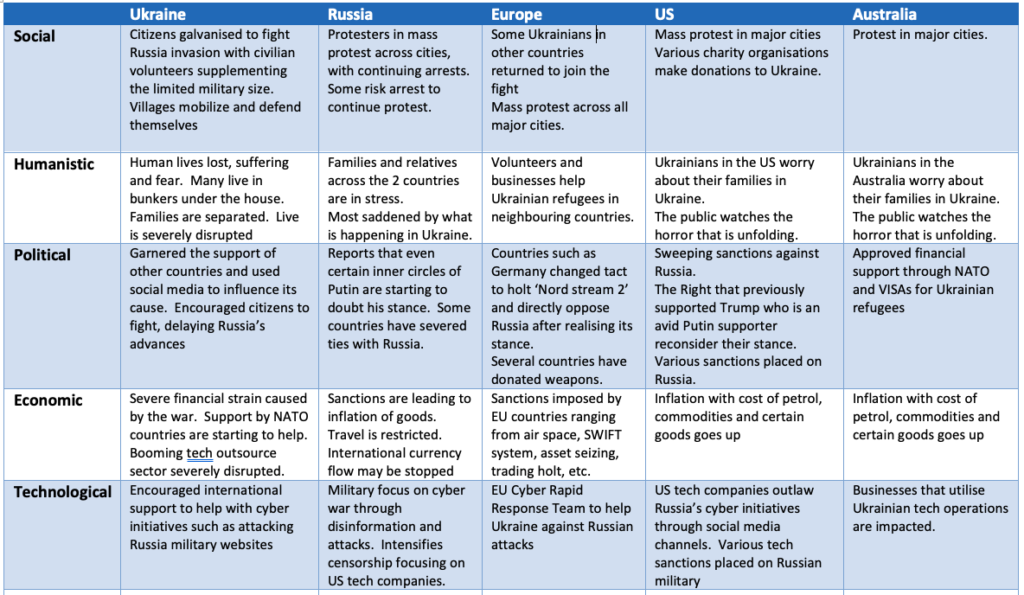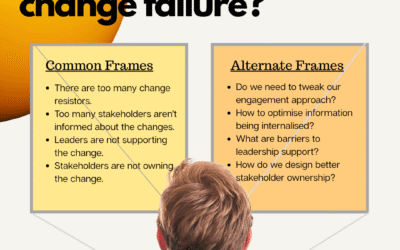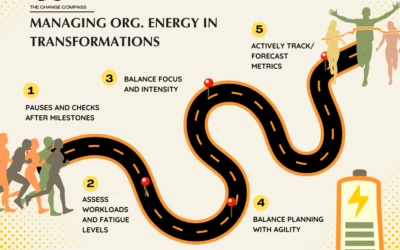Assessing the change process and conducting effective change impact assessment are critical tasks for the change manager. The reason is that a detailed change impact assessment is a map from which change interventions are pieced together to drive and manage the change process. Most aspects of change management deliverables are tied to the effectiveness of the change impact assessment. This means, if the change impact assessment was not thoroughly conducted, covering key angles and perspectives, then the overall change will likely fail.
Illustrating the effectiveness of change impact assessment is not always easy. However, we currently have a great example. Right now, Russia is attacking Ukraine with the goal of seizing Kyiv the capital. What does this have anything to do with change impact assessment and the change process?
This event is felt globally around the world in many different ways. Firstly, the most important acknowledgement has to be the horrendous human toll for the people of Ukraine. As this article is being written, there are hundreds of thousands of Ukrainian fleeing to neighbouring countries to find safety and refuge. Lives are lost and buildings destroyed.
It may seem to be that the conflict is only in Ukraine. However, the truth is much more than this. The effects of this war are felt across the world at many different levels. Let’s look into this more thoroughly as this illustrates precisely how change impact assessments should be done.

The above diagram is only a brief surface indication of a few of the impacts of the war. You can see that it is not just economic impacts, but political, social, humanistic and technological impacts. This complex web of different impacts evolve and form the overall change and disruption.
The same can also be said for organisational systems during change. Different change impacts compound and affects one another. What may be deemed as a simple process change, could impact operational factors, leadership factors, employee capacity, reporting process, system impacts, etc.
It is also worth calling out that when conducting change impact assessments different factors often converge and make it difficult to separate an impact from one category to another category. Since we are talking about a whole global system, different impacts affect one another.
Looking at this table and looking at what is unfolding in the attack on Ukraine there are some key call-outs that change managers should learn about when conducting effective change impact assessments:
1. Transitional states may be just as important as end state changes
During the change process, many things will evolve. The change impacts that happen during transitional phases need to be fleshed out and defined. Typically, what a lot of change managers do is to follow a change impact assessment template that focuses more on current state versus end-state gaps and focus on these as impacts.
However, without clearly understanding the impacts during transitions the change process will be not successfully managed and the outcome will not be reached. For example, if you had to do an impact assessment for the Russian attack on Ukraine, and you didn’t forecast the interim events that other countries will step in to support Ukraine or that Russian people will protest then the overall tactics used could be very different.
2. The change process may not be linear
A key observation of the change that is happening around the world resulting from the attack on Ukraine is that the direction, pace and volume of change is not linear. It is systemic and even organic/viral.
Within a war, setting change may be counted on a daily basis in terms of progress. In an organisational change setting, and particularly for complex changes, the same comparison can also be drawn. Complex changes are often not one-directional in terms of A affects B, or because of process change A, process B is changed as a result. There could be a complex web of changes with multiple processes impacting each other. There could also be impacted processes that as a result impact other processes.
When we look at the evolvement of this conflict, the human impacts are just as complex. First is the civilian tolls with mothers and children fleeing to neighbouring countries. Ukrainian men from neighbouring countries return to Ukraine, crossing the same borders in the reverse direction, to help the country fight. More and more civilians enlist as volunteer fighters. There are records that many residents dare to directly confront Russian military personnel. There are families across both Russia and Ukrainian borders that are caught in this conflict. There are even reports of discrimination against black refugees fleeing from Ukraine at border controls. The diverse nature of impacts is huge.
With complex organisational changes, similar comparisons can be made in that the change evolution can be systemic and organic/viral. Leaders, influencers and networkers can have a strong influence over the organisation. Formal and informal organisational networks such as internal communication channels, functional groups and centres of excellence all exert influences on shaping the change. The trick is to understand the key drivers of influence, change, communication and engagement within the impacted stakeholder groups and use these to design the change process.
3. Every perspective should be assessed to ensure potential gaps are covered
In implementing change often there are perspectives that are not considered and these usually show up during the implementation and can potentially derail the project. This often happens when the change seems simple and so stakeholders usually resort to what has occurred in the past. However, no company is operating in a vacuum and organisational situations evolve constantly.
The key is to thoroughly consider each perspective, whether it is the perceptions of each group of stakeholders, downstream impacts of process on operations and planning, or potential role changes resulting from workload changes or oversight required. Understanding the interplay between each of these is key.
4. Anticipate tactics in altering the change process
In a war situation, both sides constantly assess the situation in a super agile environment to constantly pivot from a tactical perspective to influence the outcome. For example, Russia resorted to strict censorship and mass arrest of domestic protesters to control any opposition to the attack. Russia also exerted significant influence over US social media channels in Russia to adhere to its censorship objectives.
On the other hand, Ukraine’s Prime Minister Zelensky resorted to grassroots support at a national level and an international rallying approach to appeal for support. He is constantly on social media to appeal to the people of Ukraine to take up arms and fight for Ukraine, and this is one of the key tactics in slowing down Russia’s advances. He also proactively appealed to international leaders for financial and military support.
In a change impact assessment setting, anticipate key tactics of key stakeholder groups to support or resist the change. Document and list down previous or likely tactics used by these stakeholder groups to drive the change further, to slow down the change, or to resist the change. Leverage these perspectives and build these into the change approach to derive a much more systemic approach to achieving the change outcomes.
In Summary, whilst our first response to what is happening in Ukraine is strongly on the suffering of the Ukrainian people and the wish for the suffering to end. As the conflict unfolds it teaches us some very important lessons about change and disruption and how complex, organic and dynamic they can be. There are some important lessons on effective approaches in conducting change impact assessments and assessing the overall change process.
Acknowledgement: Featured photograph from The Independent






